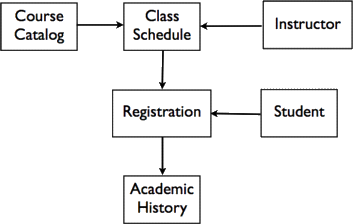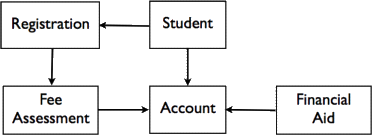|
|
IntroductionTable of contents
OrganizationThe information maintained in the Student Information System (SIS) is organized into logical or functional areas. Most of these areas are dependent on, or make use of, information from other areas. The schedule of classes, for example, uses information from the course catalog, all nearly all forms use validation information.
At a later time, Registration information is updated with grades and is used to create permanent records in Academic History. Each functional area is dependent on information from those that preceed it, and tasks can't be correctly performed in one area unless accurate and complete information is present elsewhere in the database.
Fee Assessment, for example, uses information from the Student and Registration areas (along with information on course fees that are defined in the Course Catalog) to determine a student's tuition and fees each term.
|

 The primary student information elements are organized as shown to the right.
The primary student information elements are organized as shown to the right.  The other significant module that is part of the SIS is
The other significant module that is part of the SIS is